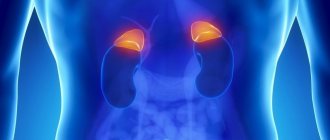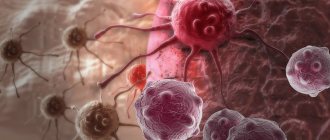Malignant tumors are a group of diseases characterized by uncontrolled proliferation of cells, their spread in the body, the formation of primary and metastatic tumor foci (with the exception of leukemia, in which solid tumors do not form). Oncologists are involved in the diagnosis, treatment and prevention of these pathologies.
Our expert in this field:
Sergeev Pyotr Sergeevich
Deputy chief physician for medical work, oncologist, surgeon, Ph.D.
Call the doctor
The prevalence of cancer in the modern world continues to grow, primarily due to an increase in the average life expectancy of the population, as well as the spread of risk factors associated with lifestyle and the environment. Malignant tumors occupy the second place among the causes of mortality after cardiovascular pathologies, but in developed countries they are already gradually taking leading positions. Thus, according to the World Health Organization (WHO), in 2021, cancer caused the death of 9.6 million people. Every sixth death in the world occurs from cancer.
But there is also a positive dynamic. Modern medicine is increasingly successfully fighting cancer pathologies, and the survival rate among patients is increasing. Oncology is one of the most rapidly developing areas of medicine; new technologies, treatment approaches, and antitumor drugs appear regularly. Although the complete victory over cancer is still very far away, the capabilities of oncologists are constantly growing.
Classification and prognosis
Neoplastic processes that can arise in the body can differ greatly in morphological characteristics, preferences of one tissue or another, the ability to metastasize, clinical course and prognosis, although they are all often combined into one word - cancer, which is a malignant tumor of epithelial tissue .
Oncological processes of a different origin that carry “evil” have different names. Thus, the classification of malignant neoplasms is based on various (main) characteristics of the neoplastic process:
- Morphological features of the tumor (its type, degree of malignancy);
- Localization of the primary focus;
- The size of the tumor, its growth rate;
- The ability of this type of neoplasia to metastasize.
TMN classification using the example of the thyroid gland The international classification (TNM –
t umor, n odus, m etastasis) of malignant tumors is voluminous and for the most part incomprehensible to a person far from the terminology of the fundamental sciences of medicine, however, when forming groups of tumors, it is primarily focused on prognosis for cancer in various stages, and stages are determined by:
- The prevalence of the primary lesion at the time of its detection (T);
- Reactions of regional lymph nodes (N);
- The presence or absence of distant metastasis (M).
In addition, each tumor process (taking into account localization) can be classified according to individual parameters:
- According to clinical signs (clinical classification), that is, according to data obtained using various diagnostic methods;
- Based on the pathomorphological features of the tumor, which are determined by histological examination;
- Depending on histopathological differentiation (poorly differentiated tumors are more dangerous and “meaner”, they quickly grow into neighboring tissues and metastasize to distant organs).
All these classification issues are very difficult for a non-specialist, but patients are more interested in what the prognosis is for cancer of a certain localization depending on the stage of the process, because it is obvious that tumors with different morphological structures will behave differently in the body. In this regard, the stage of cancer is perceived, perhaps, as the most reliable prognostic criterion not only by doctors, but also by patients.
Digestive system
Type 3. Stomach cancer
Main characteristics of the disease
The disease is becoming less common in developed countries. In Japan, stomach cancer is at a high level due to a specific diet (smoked and salty foods).
Risk of spread (metastasis)
- The lymph nodes;
- Bones;
- Lungs;
- Peritoneum;
- Liver.
Treatment of the disorder
For localized forms:
- Surgical intervention.
For metastases:
- Chemotherapy.
Type 4. Biliary tract cancer
Main characteristics of the disease
The presence of stones in the gallbladder increases the risk of bile tract cancer.
Risk of spread (metastasis)
- Lungs;
- Peritoneum;
- Liver.
Treatment of the disorder
- Surgical intervention.
Type 5. Liver cancer
Main characteristics of the disease
The disease usually occurs as a complication of liver cirrhosis:
- due to alcohol;
- due to hepatitis B or C.
Risk of spread (metastasis)
- Peritoneum;
- Bones;
- Lungs.
Treatment of the disorder
- Surgical intervention (with removal of part of the organ or transplantation);
- Metabolic radiotherapy;
- Arterial obstruction (obstruction);
- Intra-arterial liver chemotherapy;
- Injecting alcohol into tumors.
Type 6. Pancreatic cancer
Main characteristics of the disease
As a rule, the diagnosis is confirmed late due to the deep location of the organ.
Risk of spread (metastasis)
- Lungs;
- Peritoneum;
- Liver;
- The lymph nodes.
Treatment of the disorder
For localized forms:
- Surgical intervention.
For metastases:
- Chemotherapy.
Type 7. Esophageal cancer
Main characteristics of the disease
The main causes of this disorder are:
- smoking;
- alcohol.
Risk of spread (metastasis)
- Liver;
- Lungs;
- The lymph nodes.
Treatment of the disorder
For localized forms:
- chemotherapy;
- radiotherapy;
- surgical intervention.
Type 8. Small intestine cancer
Main characteristics of the disease
It occurs predominantly in men over 60 years of age. In Central Asia, the majority of patients were recorded.
Risk of spread (metastasis)
- Lungs;
- Peritoneum;
- Bladder;
- Ovaries;
- Pancreas;
- Adrenal glands;
- Liver;
- The lymph nodes.
Treatment of the disorder
For localized forms:
- Surgical intervention.
For metastases:
- Chemotherapy.
Type 9: Rectal or colon cancer
Main characteristics of the disease
The biggest risk factor is considered to be a diet rich in fat and poor in fiber.
Risk of spread (metastasis)
- Lungs;
- Peritoneum;
- Liver;
- The lymph nodes.
Treatment of the disorder
For localized forms:
- Surgical intervention.
Types of tumor
Malignant formation is divided into the following types:
- By cell type: glioma;
- epithelial carcinoma;
- bone marrow leukemia;
- lymphoma;
- sarcoma;
- embryonal teratoma;
- Choriocarcinoma.
- By location:
- larynx;
- thyroid;
- lungs;
- leather;
- bones;
- blood;
- mammary gland;
- colon;
- stomach or pancreas;
- prostate gland or testicles;
- uterus.
Respiratory system
Type 1. Cancer of the trachea, lung or bronchial tubes
Main characteristics of the disease
About 95% of all cases of the disease are seen in people who smoke.
It is the most common type of cancer in men.
Risk of spread (metastasis)
- Pericardium;
- Brain;
- Liver;
- Leather;
- Bones;
- Pleura;
- The lymph nodes.
Treatment of the disorder
For localized forms:
- surgical intervention;
- radiotherapy.
For metastases:
- chemotherapy.
Type 2. Pleural cancer
Main characteristics of the disease
One of the reasons is prolonged inhalation of asbestos dust.
Risk of spread (metastasis)
- Peritoneum;
- Rib cage.
Treatment of the disorder
For localized forms:
- Surgical intervention.
For metastases:
- Immunotherapy;
- Chemotherapy.
It all depends on the stage
Without delving into numerous classification characteristics, we will try to consider similar prognosis options for various forms of neoplasia depending on the stage. There are five of them:
Stage 0
Stage 0 includes cancer of any location. The boundaries of cancer at stage zero do not advance beyond the boundaries of the epithelium, which gave rise to the neoplasm. An example of stage 0 is carcinoma in situ, a non-invasive (for the time being) epithelial tumor. With timely diagnosis and adequate treatment, this cancer is completely curable .
Stage 1
At this stage, the cancer, in search of a place, slowly expands its borders, but does not go far and does not affect distant organs. The only exception is stomach cancer, which already at the first stage metastasizes to the lymph nodes. Basically, the prognosis for this stage is favorable , the patient can count on healing, the main thing is early diagnosis and immediate measures to eliminate the tumor.
Stage 2
Stage 2 is distinguished not only by the progression of the process in the primary focus, but also by the beginning of metastasis to the lymph nodes (regional). The prognosis for stage 2 cancer depends on the type and location of the tumor.
stages of cancer using the example of an intestinal/esophageal tumor; at stage 4, separated metastases are formed
Stage 3
Here, further progression of the disease is noted, the penetration of cancer into the lymph nodes is obvious, but there are no distant metastases yet, which is an encouraging factor for prolonging the patient’s life. Survival rates for stage 3 cancer are also different for each tumor. The location, type, degree of differentiation of neoplasia, the general condition of the patient and other factors that aggravate the course of the disease or, conversely, help prolong life, all play a role.
To the question whether stage 3 cancer can be cured, the answer will most likely be negative, because even in the absence of obvious distant metastases, the malignant process has already taken power over the human body, so one cannot count on a long and happy life with stage 3 cancer. The patient's life expectancy depends entirely on the degree of evil brought by the tumor.
Stage 4
Stage 4 is the terminal stage of cancer. Damage to an organ, lymph nodes, metastases to distant organs. However, it should be noted that stage 4 cancer can be diagnosed in the absence of distant metastases. Common, rapidly growing primary tumors or small neoplasms that affect the lymph nodes are also sometimes referred to as stage 4 of the malignant process. Some poorly differentiated tumors and undifferentiated thyroid cancer are also included here, regardless of the size of the tumor and the condition of the regional lymph nodes, but when distant metastases are detected. A cure for stage 4 cancer is in great doubt, or rather, it is completely excluded; even if the primary tumor is completely destroyed, distant metastases will still “eat the person.”
Thus, cancer at the initial stage can be destroyed at the root by the active actions of oncologists, and a cure for stage 4 cancer is in principle impossible. Claims that someone somewhere managed to cure stage 4 cancer with soda, folk remedies or some other unconventional method are often an advertising ploy by various charlatans and have no basis, and people who have overcome stage 4 cancer and are able to support or refute Pseudoscientific arguments, unfortunately, simply do not exist. Otherwise, it is another disease, which the patient himself mistook for cancer.
Each tumor has its own prognosis
It is not only difficult but also impossible to describe the stages of all tumors. Meanwhile, it is worth trying to acquaint the reader with the symptoms of cancer at the initial stage for tumors that the patient himself can detect (superficial types), as well as with the course and prognosis of the most common neoplastic processes localized in the main human organs.
What is the prognosis for the disease?
To determine prognosis, the 5-year survival rate statistic is used, which reflects the percentage of patients still alive 5 years after diagnosis.
As with other cancers, the prognosis depends primarily on the extent of the process. At stages I-II, when the process is localized in the salivary gland and does not go beyond its limits, this figure can reach 94%, at stage III and damage to the lymph nodes - 65%, and in the case of stage IV and distant metastases - 35%.
Causes of intoxication
The main cause of cancer poisoning is the process of tumor decay. Metastases coming from the neoplasm spread throughout the body. Toxins penetrate the blood and tissues and disrupt metabolism.
Tumor intoxication can occur for the following reasons:
Cancer tumor under a microscope
- Dead tissues enter the bloodstream as they decay.
- Metabolism failure.
- Kidney tissue is affected, causing complications in the excretory system.
- Micronutrient deficiency causes disturbances in the functioning of the heart and nervous system.
- Development of severe anemia and present hemolysis.
- Blood poisoning with toxins and organ failure.
In case of cancer, intoxication may appear during chemotherapy procedures. It is not recommended to avoid treatment - this will cause the growth of a malignant neoplasm and hasten death.
Nervous system
Type 23. Primary tumors of the brain and meninges
Main characteristics of the disease
These types of tumors account for 1% of all cancer cases.
Tumors appear as a result of cancerous transformation of the supporting tissue of nerve cells.
Risk of spread (metastasis)
No metastases.
Treatment of the disorder
- Radiotherapy;
- Surgical intervention.
Type 24. Tumors of the peripheral nervous system
Main characteristics of the disease
These types of cancer are formed as a result of cancerous transformation of nervous tissue.
Risk of spread (metastasis)
Metastases are possible.
Treatment of the disorder
- Surgical intervention.
Cancer on the surface
Cancer localized on the skin and visible mucous membranes at the initial stage can be suspected by the person himself if he is inclined to carefully monitor his health.
Skin cancer initially appears as a small spot or nodule, which is not particularly cause for concern. If, over a long period of time, it does not disappear, does not go away with the use of various pharmaceutical and folk remedies, it is better for the patient to immediately consult a doctor for clarification of the origin of unknown and unusual elements of the skin.
skin tumors: 1 - mole, 2 - nevus dysplasia (moles), 3 - actinic keratosis, 4 - squamous cell carcinoma, 5 - basal cell carcinoma, 6 - melanoma
The initial stage of tongue cancer is asymptomatic in most cases, but painful cracks, ulcers, erosions, and indurations should alert you to the development of an oncological process.
leukoplakia of the tongue, papillomatosis, erosive changes in the mucosa - common precancerous conditions
early stage lip cancer
Lip cancer is not so common; smokers or people who irritate this area in other ways suffer more. Symptoms of cancer (non-healing cracks, ulcers, peeling, in general, everything that should not be there) are not so painful for the patient that he quickly runs to the doctor, but in vain, because cancer at the initial stage can be cured. This will be very difficult to do in the future.
The initial stage of throat cancer occurs with symptoms of inflammation, so patients attribute everything to manifestations of a common chronic disease and, as a rule, do not rush to see a doctor.
Neoplastic processes that have found a place on the tongue, lips, and throat are combined into one pathology - oral cancer.
Genital cancer. Uterine cancer
Tumors of the genital organs are malignant formations that can affect external and internal organs.
Uterine cancer is common among women. Types of uterine cancer affect women from 55 to 70 years of age, but exceptions often occur when very young women are examined and given a terrible diagnosis - endometrial cancer. There is a hormonal type and an autonomous one.
- Hormonal cancer is a “younger” cancer that occurs in women under 40 years of age who, at a young age, suffered from problems with conception, diabetes, hyperglycemia and other problems.
- Autonomous is observed in older women - 60-70 years old. Such patients have a reduced sensitivity to hormones and the absence of metabolic disorders of the endocrine system.
Leading clinics in Israel
Assuta
Israel, Tel Aviv
Ikhilov
Israel, Tel Aviv
Hadassah
Israel, Jerusalem
If measures are not taken to eliminate this condition, the person quickly weakens, loses weight, and even cachexia. First, a precomatose state occurs, then the person falls into a coma, after which the death of the patient may follow.
Rapid growth and high aggression – lung cancer
Fast-growing, very malignant and very common neoplasms, claiming thousands of (mostly male) lives every year. That's right, this definition primarily concerns lung cancer, which outstrips neoplasia of other localizations in growth and reaches the final stage in a short time, leading a person to his deathbed.
At the first stage of lung cancer, the size of the tumor usually does not reach 3 cm, the neoplasm does not leave the “place of birth” (segment), and gives practically no symptoms of its presence. Patients may associate any manifestations such as cough, shortness of breath, or chest pain with the presence of another pathology, for example, chronic bronchitis. Meanwhile, early diagnosis of cancer with actively initiated treatment at the first stage gives a fairly high survival rate (up to 80%).
The second stage also tends to disguise itself as relative well-being, but the size of the lesion doubles (up to 6 cm). The neoplastic process still remains within the lung lobe, but is already beginning to “show interest” in nearby lymph nodes, dispersing single metastases. Cough, sputum (sometimes with blood), pain, fever, signs of intoxication again resemble an exacerbation of long-term chronic diseases of the bronchopulmonary system. This usually confuses the patient, so he does not see a doctor for a long time, thereby wasting valuable time. But the combination of chemotherapy and radiation therapy with radical treatment ensures survival rate for stage 2 cancer up to 50%. As they say, fifty-fifty, and that’s a lot.
The third stage of the malignant process in the lungs is characterized by further growth of the tumor, which exceeds 6 cm in size and, having affected the lung, metastasizes to nearby lymph nodes.
The last stage (fourth) has a large tumor that has left the borders of the lung, invaded neighboring organs and spread metastases through lymphatic and blood vessels throughout the body. Terminal stage cancer leaves the patient with only a few months to live. The body is destroyed by a tumor, existing treatment methods are useless or can only alleviate suffering, but not really improve the condition. A cure for stage 4 cancer can only be a dream, and people who have overcome stage 4 cancer can only be met on dubious forums on the Internet... But this has already been said before.
Blood and lymphatic system
Type 21. Leukemia (leukemia)
Leukemia is a blood cancer that results from abnormal (acute or chronic) proliferation of white blood cell precursors in the bone marrow.
Main characteristics of the disease
The main causes of the disorder are:
- exposure to benzene;
- chemotherapy and radiotherapy (in rare cases, therapy for other types of cancer can cause leukemia).
There are 5 main types of leukemia:
- Acute types: myeloblastic leukemia (in adults);
- lymphoblastic leukemia (in children).
- myelocytic leukemia;
Risk of spread (metastasis)
Leukemia has a diffuse mechanism of spread.
Treatment of the disorder
- Acute types of disease: bone marrow transplantation;
- intensive chemotherapy;
- immunotherapy (using interferon);
- Vitamin A derivative preparation.
- immunotherapy;
Type 22. Lymphoma
Lymphoma is cancer of the lymphatic system (spleen, liver, lymph nodes).
Main characteristics of the disease
The HIV virus, which causes AIDS, can affect the development of lymphoma.
There are 2 main types of lymphoma:
- Hodgkin's disease (this disorder has a very high healing rate);
- non-Hodgkin's lymphomas.
Risk of spread (metastasis)
Lymphoma has a diffuse mechanism of spread.
Treatment of the disorder
- Surgical intervention;
- Radiotherapy;
- Chemotherapy (for aggressive types of disease).
Anesthesia
For excruciating pain, narcotic painkillers such as Fentanyl are administered. Pain is the most striking symptom at the last stage; it is caused by the inflammatory process in the malignant formation and its effect on the nervous tissue. The only way to help a patient is with painkillers. They are assigned individually and in the following sequence:
- Anti-inflammatory drugs (NSAIDs) - relieve minor pain.
- Painkillers (Ketorol). Relieves pain of medium intensity.
- Narcotics (“Morphine”, “Fentanyl”). Able to deal with severe, debilitating pain.
Causes of malignant neoplasms
Scientists have identified a number of causes of malignant neoplasms that can trigger the development of cancer. For convenience, they are usually divided into two large groups: endogenous and exogenous.
Let's take a closer look at each of them.
Endogenous causes of malignant neoplasms:
- immunological hereditary abnormalities (combined immunodeficiency, X-linked agammaglobulinemia, etc.);
- formation of hereditary neoplasms (diffuse polyposis, multiple endocrine adenomatosis);
- an increased risk of malignant formation, but with an unproven hereditary connection, is present in organs such as the lungs, mammary glands, endometrium, large intestine, stomach;
- disruption of the endocrine system;
- the presence of pathologies predisposing to malignant degeneration of cells (for example, xeroderma pigmentosum, Peutz-Jeghers or Down syndrome, Recklinghausen syndrome, multiple exostoses).
Exogenous causes of malignant neoplasms:
- acquired immunodeficiencies;
- radiation with a low dose of exposure (diagnosis using X-ray devices, ultraviolet irradiation, etc.);
- radiation with a high degree of radiation exposure (nuclear weapons, radiation therapy, nuclear power plant accidents);
- the influence of chemical carcinogens, in particular industrial products (inorganic compounds - nickel, chromium, arsenic, cadmium, etc., organic compounds - asbestosis, gasoline, vinyl chlorides, coal tars, benzidine, etc.);
- negative effects of certain medications (immunosuppressants, alkylating medications, testosterone, estrogen, procarbozines, phenacetin, etc.);
- exposure to bad habits (drinking alcohol and smoking);
- incorrect and irrational diet;
- improper processing of products and poor hygiene;
- infection with infectious elements - fungi (aflotoxin), parasites (schistosomiasis), hepatitis B, African Burkitt's lymphoma, hepatocellular cancer, nasopharyngeal carcinoma.
Subject of special attention – breast cancer
It is often possible to “catch” cancer at the initial stage in lesions of the mammary gland (MG). The best diagnostician in this case is the woman herself or (which happens quite often) her husband. This is explained by the fact that the female breast is not only an organ used to feed a child. She is an object of adoration and admiration among people of the opposite sex, so the attitude towards her is especially reverent and there is increased attention. Meanwhile, not everyone can successfully find the primary focus and cope with carcinoma in situ (non-invasive epithelial tumor); in some, the disease goes through all stages of breast cancer:
characteristic cancerous and precancerous breast changes that are worth paying attention to
- Stage zero - carcinoma in situ (intraductal tumor, lobular cancer, Paget's disease) - a pre-invasive form that gives every chance of complete healing.
- The first stage of breast cancer: the tumor is small, its diameter does not exceed 2 cm, it has not yet sprouted anywhere and, moreover, has not given rise to metastatic growth, the prognosis, of course, is favorable.
- Second stage: the size of the tumor in stage 2 cancer ranges from 2-5 cm, the tumor began to invade additional territories, growing into neighboring tissues, and metastasizing to the lymph nodes.
- The seriousness of the third stage lies not only in the growth of the tumor, its penetration into neighboring tissues and nearby lymph nodes, but also in the transfer of cancer cells to distant organs. After all, even with radical treatment, evil can lurk, and after 10-15 years (this can be the life expectancy for stage 3 breast cancer) remind itself of itself in order to have a fatal outcome, which is why stage 3 cancer is considered incurable.
- For the fourth stage of breast cancer, the size of the primary lesion no longer matters. The worst thing about stage 4 cancer is that tumor growth has completely taken over the lymphatic system, “occupied” the chest and spread to the entire body in the form of metastases to distant organs. Cure from stage 4 cancer is impossible by any means, because the scattered “evil” can no longer be collected throughout all the tissues of the body. Radiation and chemotherapy may delay neoplastic growth for some time, but not for long - with stage 4 cancer, life expectancy is from one to three years.
breast cancer stages
By the way, breast cancer is not excluded in males, although this happens very, very rarely.
urinary system
Type 25. Kidney tumors
Main characteristics of the disease
There is a rare form of embryonal cancer in children (nephroblastoma).
Risk of spread (metastasis)
- Brain;
- Liver;
- Bones;
- Lungs;
- The lymph nodes.
Treatment of the disorder
For localized types:
- surgical intervention.
For metastases:
- immunotherapy.
Type 26. Bladder cancer
Main characteristics of the disease
The main causes of bladder cancer are:
- schistosomiasis;
- chemical dyes;
- smoking.
Risk of spread (metastasis)
- Liver;
- Bones;
- Lungs;
- The lymph nodes.
Treatment of the disorder
For localized superficial forms:
- immunotherapy;
- chemotherapy.
For localized deep forms:
- radiotherapy;
- surgical intervention.
For metastases:
- chemotherapy.
Type 27. Prostate cancer
Main characteristics of the disease
As a rule, the disease occurs in older people.
It is a hormone-dependent type of cancer.
Risk of spread (metastasis)
- Liver;
- Bones;
- Lungs;
- The lymph nodes.
Treatment of the disorder
For localized types:
- radiotherapy;
- surgical intervention.
For metastases:
- chemotherapy;
- surgical or chemical castration;
- hormonal therapy.
About disability pensions, annual benefits and reports from social workers
Zhenya offers to drink coffee, and we go to the kitchen. Knowing that the second group of disabilities is non-working, I ask him on what means he lives.
- I receive a disability pension - 2.2 million, from this amount I pay alimony. The total remains 1.8. “I’m lucky that I live with my mother, otherwise I would have to eat pasture,” he answers. “For the entire time I spent in the first group, the social worker called me only once. Every year I write an application to the Social Security Administration for the allocation of financial assistance. And once a year the state allocates me 700 thousand.
Photo: Natalia Prigodich, Names
Zhenya says that he used to receive financial assistance without any questions. This year everything was different:
“The social worker calls me and asks: “Why do you need help? What are you going to spend this money on? I was dumbfounded at first, then I told her that my immune system is weak, I get colds often and am sick for a long time - a lot of money is spent on medicines, and they are expensive now. She immediately bombarded me with other questions: “Can you list what specific medications you buy? How much does your mother earn? Where does your brother work? How much do you spend on utilities per month? Some kind of nonsense: what does my brother, mother have to do with it, I’m already 34 years old! “We need to report,” the social worker told me. “So we’re conducting a survey.”
Purely women's problems
The most vulnerable place of the main reproductive organ of women
Cervical tumors have become significantly “rejuvenated” in recent years, which experts associate with the spread of papillomavirus infection (HPV). Meanwhile, there is a high probability of detecting a neoplastic process at the stage of its inception, and in other stages this type of oncology is relatively well diagnosed. Thus, before becoming real cervical cancer, the development of the tumor goes through several stages:
-
Precancerous conditions of the cervix - dysplasia,can be treated well if treated in time, but in the last degree (CIN III) it is difficult to distinguish it by cytological method from carcinoma in situ, which is one step away from dysplasia 3 and represents the zero stage of the tumor process. Histological examination, capable of detecting invasion, copes with the task remarkably well, which makes it possible not only to recognize, but also to cure the tumor.
- Stage 0 – carcinoma in situ. The prognosis is favorable; with early diagnosis, this cancer can be cured in 100% of cases.
- A predominantly favorable prognosis is also observed in the first stage of cancer, because the tumor, which has grown to approximately 4-5 cm, is still within the boundaries of the epithelium of the main reproductive organ.
- At the second stage, the malignant process leaves the uterus, but as long as it does not affect neighboring organs, the prognosis remains encouraging.
- Third stage. The tumor “takes root” in nearby tissues, thereby significantly worsening the prognosis
- The last stage is the fourth. The cancer “crossed all boundaries”, grew into the organs of the excretory (bladder) and digestive (rectum) systems, its metastases reached distant organs. Surgical treatment will no longer help, there is nothing to calm the woman down, doctors can only try to alleviate the patient’s suffering.
stages of cervical cancer
The prognosis for cervical cancer, as with other tumors, depends on the stage. Factors such as the type of cancer and the degree of differentiation of neoplasia are also of considerable importance (the higher the degree, the greater the chance of survival).
The main “killer” of gynecological oncology
Ovarian cancer, having many forms and types, is considered the most unfavorable and uncontrollable oncological process in the female genital area. The most common type is a tumor of the glandular tissue of the ovaries - adenocarcinoma, which is particularly cruel and aggressive. The insidiousness of ovarian cancer also lies in the fact that it presents particular difficulties in diagnosis. The existing symptoms are well linked to the manifestations of chronic gynecological diseases (adnexitis, uterine fibroids, etc.). However, some signs should still alert a woman:
- causeless weight loss without dieting or exercise;
- progressive enlargement of the abdomen (accumulation of fluid in the abdominal cavity - ascites);
- indigestion.
Ovarian cancer, like other tumors, goes through 4 stages:
- The “birth” of a cancer cell, the development of the process within one ovary. The appearance of ascites is possible already at the first stage of cancer, which gives some hope for its early diagnosis and prolongation of life by 5 years in 80% of patients (of course, provided that surgical treatment is combined with other methods).
- In the second stage, both ovaries, peritoneum, fallopian tubes and uterus are affected. An enlarged abdomen (ascites) with general weight loss tells a woman about the development of a bad disease; the prognosis, of course, worsens.
- The third stage is no longer difficult to diagnose; problems can be noticed even during a routine gynecological examination. Survival rates for stage 3 cancer are low; only every tenth woman in a hundred has a chance to live five years.
- Stage 4 cancer is characterized by the spread of metastases throughout the body, but most often they can be found in the lungs and liver. There is no talk of a cure for stage 4 cancer; survival rates are reduced to zero.
The prognosis cannot be the same for everyone; one cannot speak in general about the stage of cancer and life prospects, because in each specific case other factors are taken into account: the histological features of the tumor, the age of the patient, the condition of other organs. Some people can fight longer, while others give up in the first months.
Why do malignant tumors occur?
A normal cell becomes a tumor cell as a result of certain changes in genes:
- Proto-oncogenes regulate cell maturation and reproduction. As a result of mutations, they turn into oncogenes and contribute to malignant degeneration.
- Tumor suppressor genes normally perform protective functions: they “repair” DNA in which errors have occurred, or, if this is not possible, cause the death of the damaged cell. As a result of disturbances in these genes, mutations continue to accumulate in cells.
In each specific case, it is impossible to name the exact reasons that caused the mutations and led to the development of cancer. This is a very difficult process. But risk factors are well known that increase the likelihood of a malignant formation or tumor. The most common risk factors:
- Age. Most often, people over 40–50 years of age suffer from cancer, as mutations accumulate in the body's cells over time.
- Family history: if close relatives have already been diagnosed with cancer.
- Some inherited mutations that are present in the body's cells from birth.
- Smoking is the most significant lifestyle risk factor.
- Excessive alcohol consumption.
- Exposure of the skin to ultraviolet rays.
- Unhealthy diet with a predominance of red and processed meat, foods high in “fast” sugars.
- Overweight, obesity.
- Some infections: viral hepatitis B and C, HPV.
It is important to understand that risk factors are not direct causes of the development of malignant tumors; none of them leads to cancer with one hundred percent probability.
Some risk factors, such as age, gender, and family history, cannot be influenced. But many factors are related to lifestyle, and each person can protect himself from them. According to WHO experts, a third of all cancer cases are associated with factors such as low physical activity, excess weight, unhealthy diet, alcohol consumption and smoking.
Treatment
The treatment regimen depends on the stage, location and extent of spread of the tumor process. Standard therapy includes surgery, a course of chemotherapy and radiation therapy.
In complex treatment regimens, Indian generics of anticancer drugs are used, which improve the tolerability of chemotherapy and speed up the recovery process. Medicines with appropriate quality certificates can be purchased at the India Express online pharmacy https://india-expres24.com/onkologiia/. The medications described are not intended for self-medication and can only be used with prior agreement with a doctor.
Respiratory system
Type 17: Cancer of the mouth, larynx or pharynx
Main characteristics of the disease
The main reasons for the violation are:
- alcohol;
- smoking.
Risk of spread (metastasis)
- Bones;
- Lungs;
- The lymph nodes.
Treatment of the disorder
For localized forms:
- radiotherapy;
- Surgical intervention.
For metastases:
- Chemotherapy.
Type 18. Cancer of the sinus or nasal cavity
Main characteristics of the disease
The reasons may be:
- some viruses from Asia and the Mediterranean;
- wood powder from some exotic trees.
Risk of spread (metastasis)
- Liver;
- Lungs;
- The lymph nodes.
Treatment of the disorder
For localized forms:
- surgical intervention;
- chemotherapy;
- radiotherapy.
For metastases:
- chemotherapy.
Gastrointestinal tract
Esophageal carcinoma
Esophageal cancer is classified as a malignant and aggressive neoplastic process. It grows quickly, metastasizes early, is difficult and painful to diagnose and treat, and has a very unfavorable prognosis.
This cancer at the initial stage can mislead its owner by the absence of any specific symptoms . A person overcomes difficulties with swallowing, periodic spasms, and choking while eating with the help of liquid. I washed down my food with water - everything seemed to have passed and I could continue to live in peace, so the visit to the doctor is constantly postponed. And, by the way, thoughts of bad things rarely come to mind. However, if you detect the disease at the first stage and quickly take action, you can count on five (or even more) years of life.
Symptoms of esophageal cancer increase as the tumor develops, which goes through the same stages as other cancers (with germination and metastasis). At the same time, the prognosis is worsening.
At stages 3-4, the voice already changes, dysphagia increases, esophageal vomiting periodically appears, something is constantly bothering the chest, the patient loses weight, loses the ability to work. Survival for stage 3 cancer is low; with active treatment, approximately 25% of patients benefit, but with distant metastasis, only half of them have some prospects.
With stage 4 cancer, patients live barely six months, and this can hardly be called a full life.
Number two leader
Stomach cancer still holds the leading position in terms of incidence and mortality; it is moved into second place only by lung cancer, recognized throughout the world as the invincible “enemy of all times and peoples.” The abundance of carcinogens, bad habits, hereditary predisposition, carriage of Helicobacter pylori infection are factors contributing to the development of a tumor in this localization. Human nature is such that the stomach hears better and more often than other organs (eat, drink, smoke...). Satisfying his (stomach’s) sometimes unreasonable demands, the thrill-seeker “digs his own grave.”
The prognosis for stomach cancer largely depends on the depths the tumor reaches when immersed in the wall of the stomach. For example, early cancer that affects only the superficial layers (mucosal and submucosal) responds well to treatment, so almost all patients survive. However, such bright prospects, unfortunately, cannot await patients whose tumor, already at the first stage, has spread not only to the stomach, but has also metastasized to the lymph nodes.
stages of stomach cancer
A disorder in the stomach can be quite difficult to notice; symptoms appear late, despite the fact that the tumor can be detected by palpation. Dyspeptic disorders, weakness, aversion to food, weight loss, lack of interest in life - many people attribute these “minor signs” to their usual sensations, especially if they have suffered from ulcers or gastritis for many years. Pain appears in the later stages (3-4), when the cancer, having reached a large size, has already left the digestive organ.
The terminal stage of stomach cancer is accompanied by great suffering:
- Intense pain;
- Progressive anemia;
- Changes in the blood (leukocytosis, high ESR);
- Intoxication;
- Fever;
- Exhaustion.
The last stage leaves a stomach cancer patient with only a few months to live...
Again gender and age...
Colon cancer also goes through all of the above stages. More often it affects the large intestine of middle-aged and elderly men. The cause of its development, like stomach cancer, is often the patient’s own preferences. The first symptoms (discomfort, fatigue, nervousness) do not give much reason to suspect evil. The appearance of obvious signs (pain, intestinal disorders, bleeding in feces) is often delayed.
stage of intestinal cancer, stage 4 is characterized by metastasis to the liver
The stage of intestinal cancer, as in the case of neoplasia of other localizations, completely determines the prognosis.
Detection of an oncological process at the first stage ensures a 5-year survival rate of almost 90% of patients; as the degree increases, the chances of living for many years decrease significantly. In the last stage of intestinal cancer, the prognosis is extremely unfavorable, especially if the tumor originated in the distal rectum.
The problems of oncology are solved by specialists, however, according to the author , people far from medicine can play a big role in this if they are aware of the symptoms, stages and methods of treating malignant neoplasms. It is obvious that in most cases we can defeat cancer at the initial stage, the main thing is to detect it in time. And who, if not the patient himself, will be the first to know about the approaching disaster, but at the same time he will not rush to try dubious medicines such as soda and hemlock, but will turn to a medical institution where he will receive qualified assistance.
Primary Research
Ordinary medical examinations and “routine” tests save many people every year by signaling to the doctor about problems in the human body and making it possible to begin a narrow examination.
Complete blood count (CBC)
It is also called clinical or general clinical. This is a screening study that gives a detailed overall picture of the body’s functioning, the presence of inflammation, anemia, and blood clotting disorders.
The following changes in indicators may indicate possible local oncopathology:
- Increased ESR (erythrocyte sedimentation rate) with normal or increased leukocyte (white blood cell) count.
- A drop in the amount of hemoglobin for no apparent reason. Can occur with malignant processes of the stomach and intestines.
- A simultaneous increase in the level of ESR, hemoglobin and erythrocytes (red blood cells) may indicate kidney cancer.
However, if the UAC showed such results, you should not be alarmed. Let us repeat - this is a non-specific study, which much more often indicates other, less dangerous diseases.
In case of leukemia, the CBC becomes an important screening test - sometimes the disease is detected by chance from a blood test taken for another disease. But for this, a leukocyte formula is required (the percentage of different types of leukocytes to their total number). Therefore, when taking a blood test, do not limit yourself to the “three” - hemoglobin, ESR, leukocytes.
Leukemia is suspected when the following indicators occur:
- Very high or extremely low white blood cell count.
- Shift in leukocyte formula.
- The appearance of immature leukocytes in the blood.
- Increase in ESR.
- Fall in hemoglobin levels (anemia).
- Decreased platelet count.
In case of localized oncopathology (tumor of a specific organ), the CBC may not change, especially at an early stage.
General urinalysis (UCA)
Can help in diagnosing cancer of the urinary tract: kidneys, bladder, ureters. In this case, blood plus atypical cells will be detected in the urine. To clarify the diagnosis, a cytological urine test is prescribed.
Blood chemistry
With malignant neoplasms of the kidneys and parathyroid gland, a significant increase in calcium levels is observed.
With cancer of the liver, kidneys, and pancreas, the amount of liver enzymes increases.
Changes in the amount and ratio of hormones of different types may indicate malignant diseases of the endocrine system.
Fluorography
Helps detect lung cancer.
Last days
It is important to understand that irreversible changes occur in the body, and the outcome can be anything. Relatives should know what characteristic symptoms appear before death:
- Predagonia: hallucinations;
- pale skin;
- low pressure.
- loud wheezing;
In recent days, a cancer patient may faint under the influence of painkillers. Despite his comatose state, he can hear, so it is important for his family to tune in psychologically and support him with conversation and positive memories. And if the pain sensations can no longer be controlled, you need to be patient and, when you are nearby, show maximum care.
Symptoms of cancer intoxication
Poisoning manifests itself differently in everyone. The general condition of the patient’s body, the stage of the disease, and which organ is affected by cancer are affected. The amount of toxins in the blood and existing infections should be considered the main thing in determining the damage to the body.
Symptoms of cancer intoxication:
- Cachexia is actively developing - the inability to exercise.
- Performance decreases to extremely low levels.
- Nausea and vomiting are present.
- There may be an intestinal disorder - diarrhea, or, conversely, constipation develops.
- Intolerance to any meat.
- Lack of appetite or sudden change in gastronomic preferences.
- Anorexia in acute form.
- The skin becomes pale in color and may be jaundiced in areas.
- There is a pronounced bluish tint around the eyes.
- Dry skin on hands and feet.
- Sweating during sleep.
- High body temperature.
- Fever.
- Severe headache with dizziness.
- Frequent mood changes.
- Depressed and irritable state.
- Insomnia.
ARVI and acute respiratory infections occur in a severe form with complications. Standard treatment may not provide a healing effect. Medicines are not accepted by the affected cells of the body - a more aggressive method of treatment is required. The consequence of chemotherapy is an exacerbation of the symptoms of cancer intoxication.
General information
Cancer intoxication is a complex of disorders that occur in cancer patients when the body is poisoned by the decay products of a malignant tumor. It is detected mainly in the terminal stages of the disease and is considered one of the main causes of death in patients. In addition, cancer intoxication is often observed during chemotherapy and is a natural consequence of active anticancer treatment, which causes tumor destruction.
Cancer intoxication can provoke disturbances in the functioning of various organs and systems, including renal and liver failure, sepsis and other severe infectious complications, which makes it important to carefully select dosages and types of medications, taking into account the general condition of the patient, as well as the presence of certain chronic diseases. diseases. Treatment is carried out by specialists in the field of oncology.
Cancer intoxication
Leather
Type 19. Basal cell or squamous cell carcinoma
Main characteristics of the disease
Repeated and intense exposure to the sun is the cause of these types of carcinomas.
Risk of spread (metastasis)
- Basal cell carcinoma: No metastases.
- Bones;
Treatment of the disorder
For localized forms:
- radiotherapy;
- surgical intervention.
For metastases:
- radiotherapy;
- surgical intervention;
- chemotherapy.
Type 20. Melanoma
Risk of spread (metastasis)
Possible extension to all organs and tissues.
Treatment of the disorder
For localized forms:
- surgical intervention.
For metastases:
- immunotherapy;
- chemotherapy.











